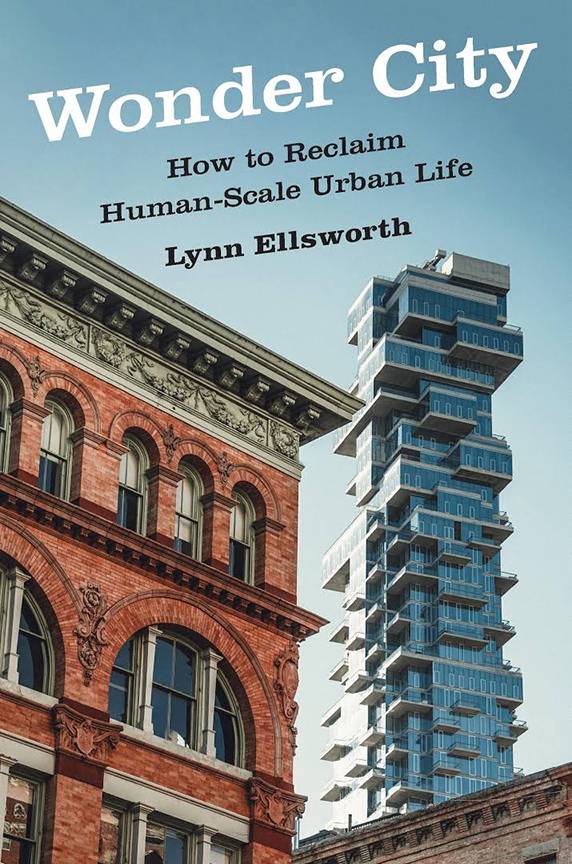Wonder City: How to Reclaim Human-Scale Urban Life
By Lynn Ellsworth
Fordham University Press, 384 pages, $34.95
If it were not such a spur to anguish, fear and fury, the second Trump administration would be a fascinating social experiment: What does it take to get people and institutions to bend to your will? When do the “compromises” proffered by Trump’s targets become craven complicity? Where can one find truth, when the mainstream media are corrupted by profits, and diminished by the ever-shrinking attention spans of a distracted public?
In Trump 2.0, so many of the threats and machinations are brazenly out in the open, as are the regime’s sycophantic ties to billionaires Elon Musk and Peter Thiel. These flagrant outrages spur actual visible resistance—viva Tesla Takedowns! We may wish to look away from the horror of this administration, but what’s sparking this dumpster fire is obvious: It’s a cinch to connect the dots between Trump’s sweeping right-wing initiatives and interests of Big Business and Big Money. And there’s still a mainstream media somewhat willing to say so.
Seducing the politicians
I thought about this with wistfulness as I pored over Wonder City, Lynn Ellsworth’s encyclopedic offensive against another tyrannical bully fueled by billionaires, namely the Real Estate Board of New York (REBNY). REBNY, the powerful New York City real estate lobby, still works by stealth. And it appears to have so seduced politicians and the mainstream media that opposing views get no respect and no press.
So one of the great virtues of Ellsworth’s book is the simple fact it exists, as a nagging, hyper-intelligent, piercing voice insisting the emperor’s wearing no clothes.
Ellsworth, an economist, unpacks and refutes the current fervent pro-development religious revival among politicians, policymakers, and much of the public: specifically, the “trickle-down” faith that any increase in housing supply—more luxury condos!—will result in lower rents and more affordable housing.
Phooey, she says; not only is “trickle down” ridiculous on its face (it ignores luxury demand, and the global investors who prop this demand up) but the “evidence” cited by its proponents doesn’t add up.
Neoliberal YIMBY’s
A further big virtue of Ellsworth’s book is that she’s done the daunting, scary work of wading into the historical and ideological muck from which REBNY’s Yes-In-My-Backyard (YIMBY) campaign emerged. It’s kind of like she’s had the guts and stamina to read the real estate and architectural versions of Project 2025 so we don’t have to.
And some of the muck she’s unearthed seems almost unbelievable. I personally would have trouble believing the zealous righteousness of super-tall-tower fans had I not witnessed them in action, descending like a crazed mob of social media trolls to attack a politico who dared gingerly to suggest that a 600-foot spire in the West Village might be “a tad” too high. Per Ellsworth, these fanatics see the sky dome as the last frontier, public space that is wasted if not fully occupied by real estate.
Turning NYC into Hong Kong
Equally stunning is her account of YIMBYs’ long-standing vehemence against low-rise neighborhoods. Architect and provocateur Le Corbusier demanded the destruction of the “dormers, eaves, mansards and the rest” of Paris, to be replaced by “terrifying, pitiless” towers, with “a forest of pillars” at ground level. His influential descendants have New York City in their sights—from the architect Vishaan Chakrabarti, who yearns to remake New York into hyper-dense Hong Kong, to economist Edward Glaeser who urges the replacement of every postwar building under ten stories with a forty-story tower and touts towerization as an exciting engine of urban renewal—displacing poor people with rich ones.
Though today’s army of YIMBYs present themselves as the face of the future, a brand new youthful vanguard poised to vanquish villainous blue-haired preservationists, Ellsworth shows YIMBYs rely on neo-liberal economic tools that remain creakily out of date. These tools—Pareto Optimality, the Kaldor-Hicks Test, “Highest and Best Use”—all seek to maximize “value.” Thus they discount everything that has no established price tag: neighborhoods and neighborliness, beautiful views, cultural ties, sustainability. It’s as if Jane Jacobs—and her incalculable wisdom about the powerful vitality of street life in low-rise urban neighborhoods—never existed.
There’s another outstanding virtue to Wonder City. Ellsworth has the insight and sheer chutzpah to take a look at the New York City Landmarks Preservation Commission (LPC) and call it out for what it has become, namely a victim of “regulatory capture” by REBNY.
“Regulatory capture” is a routine phenomenon—it’s when an oversight agency is overtaken by the industry it’s supposed to oversee. Ellsworth details the “revolving door” between New York City government and real estate and recounts the horrific story—revealed via a Freedom of Information Law request—of LPC staff actually holding a secret practice hearing with real estate developers and REBNY to help Big Real Estate achieve its ends.
Given its unique and marvelous virtues, Wonder City is indispensable, a wonder of a book. But it is also a stark illustration of how far we NIMBYs—and yes, I count myself as a proud Not-In-My-Backyard NIMBY—have yet to go before making a dent in REBNY’s successful takeover of politics and the media.
Wonder City is dense and cranky, a work of in-your-face advocacy, not persuasion. You can select among its overwhelming array of factoids to help craft an argument, but the book is, by itself, unlikely to change minds.
It’s also conspicuously out-of-date, barely referencing Eric Adams and City of Yes. At one point Ellsworth describes Bill Rudin as REBNY’s chairman “at the time of this writing”—yet Rudin’s tenure ended in 2021. While I have confidence in her sweeping portrait of the forest, I would hate to point to one of her many trees and discover it’s no longer as she describes it.
Depending on the super rich
And while Ellsworth’s critique of “trickle down” theory is obsessively thorough, I’ve come to suspect “trickle down” is a feint, a successful tactic smart politicos use to avoid discussing a politically awkward reality—New York City’s high reliance on real estate taxes. It’s just so much easier to pretend that luxury housing will magically pay off for ordinary renters than to grapple with the possibility that New York City’s solvency depends on attracting the rich and super-rich. Ellsworth does not discuss the profound implications of tax policy.
Lastly, her subtitle—“How to Reclaim Human-Scale Urban Life”—is, alas, a tease. Her “how-to” last chapter, “What Policies for a Human-Scale City?” proposes a variety of policy shifts: prosperity through investment in the public realm (such as more mass transit), zoning reforms, and “democracy reforms” such as electing and empowering community boards. Doubtless these are good ideas, but they seem sidetracks, not an effective agenda for change.
None of these strategies acknowledges the depth of our present predicament—namely REBNY’s astonishing success with messaging and securing the allegiance of politicians. A truly useful “how-to” would tackle how to reach a deluded public. It would also grapple with the outsize influence of REBNY money on politicians. Surely, tenants and preservationists could find sufficient common cause to underwrite an anti-REBNY PAC?
I like to imagine Wonder City in the hands of savvy young NIMBY propagandists—like the brilliant social media minds of Youth Against Displacement. Ellsworth’s provocative illustrations could inspire Instagram campaigns, particularly her funny/sad photos highlighting the infuriating hypocrisy of the architects and policy makers trashing historic districts and pushing for glass-and-steel behemoth towers.
She illustrates where these folks live—none of them in towers, but instead in fabulous low-rise historic neighborhoods and single family homes. OMG, starchitect Renzo Piano—who designed the repellent, super-tall, 72-story “Shard” in London—lives in Paris’ exquisite Place des Vosges, the ultimate low-rise historic district.
Wonder City won’t sway your YIMBY neighbors, but it is a bravado attempt at truth-telling. Ellsworth’s superpower consists of being a singular voice in the wilderness. Should you agree with her, Wonder City will provoke you to thought and perhaps to action. Plus having Ellsworth on your side will surely boost your morale—and who doesn’t need morale boosting, these days?




